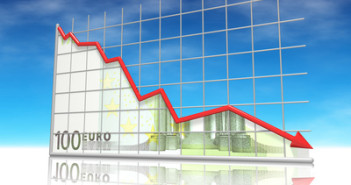Euro/dollar is backing down on its efforts to break higher. The manufacturing sector in the euro-zone is on the verge of contraction: Flash PMI has scored only 50.4 points, hardly clinging on to the positive side and significantly lower than 51.6 that was predicted. Services PMI also disappointed with a score of 51.4 points, lower than 53.2 that was estimated.Â
EUR/USD is now at 1.4240, down from a peak of 1.4293 it reached before the figures were released. It flirted with the idea of breaking above the 1.4282 line, but the test of high ground above this line was very short lived. And it has quite a few reasons to slow down:
This was expected, as the locomotive of the euro, Germany also showed signs of slowdown. According to the initial data, manufacturing PMI fell 52.1 points, lower than 54.1 that was predicted. The services sector had an even bigger disappointment: a drop from 56.7 to 52.9 points, when 56.1 was predicted.
In France, the manufacturing sector came to a standstill: the flash manufacturing PMI for the euro-zone’s second largest county disappointed with a drop to 50.1 points, on the border between growth and contraction. A score of 52.3 points was expected.
Also the French services sector disappointed with only 54.2 points, when 55.8 was expected.
All in all, these PMI number reflected a very slow pace of growth, last seen almost two years ago. Europe is not alone: also the US and China are slowing down.
At the same time of the current release, the Current Account figure was published for the euro-zone. Also here, a small disappointment awaited: the deficit edged up to 5.2 billion euros, instead of squeezing to 4.8 billion, as estimated.
EUR/USD is still far enough from support at 1.4200. Further support is at 1.4160, followed by 1.4120. For more on the euro, see the Euro/dollar.
The euro rose on hopes for a successful summit in Brussels. There is some agreement between Germany and France, but the details aren’t available.
The leaders of the EU are scrambling to find a serious solution for the crisis, which heated up as Italy and Spain also found themselves with unsustainable yields, in danger of losing access to the markets.
What Europe needs now, is QE – printing euros to lower the bonds.



